Healthy snacking can be super easy and fun! Learn how to make bliss balls, energy balls or energy bites with our thorough guide and easy-to-follow blueprint.
They taste like dessert while packing a whole lot of essential nutrients: raw or no-bake balls have conquered the internet in a storm.
Call them date balls, bliss balls or energy bites, the combination of natural sugars, healthy fats and fiber makes for a great on-the-go snack that perfectly supports your healthy eating ambitions!

download our free energy balls blueprint
Grab your free PDF and sign up for our newsletter by entering your email below!
Kids love them — they even love helping you make them! If you have bags of leftover sunflower seeds or raisins or are wondering how to include more flax seeds in your diet: bliss balls are fantastic clean-out-your-kitchen recipes.
Let’s go over what they are, why we love them and how to make bliss balls in the first place!
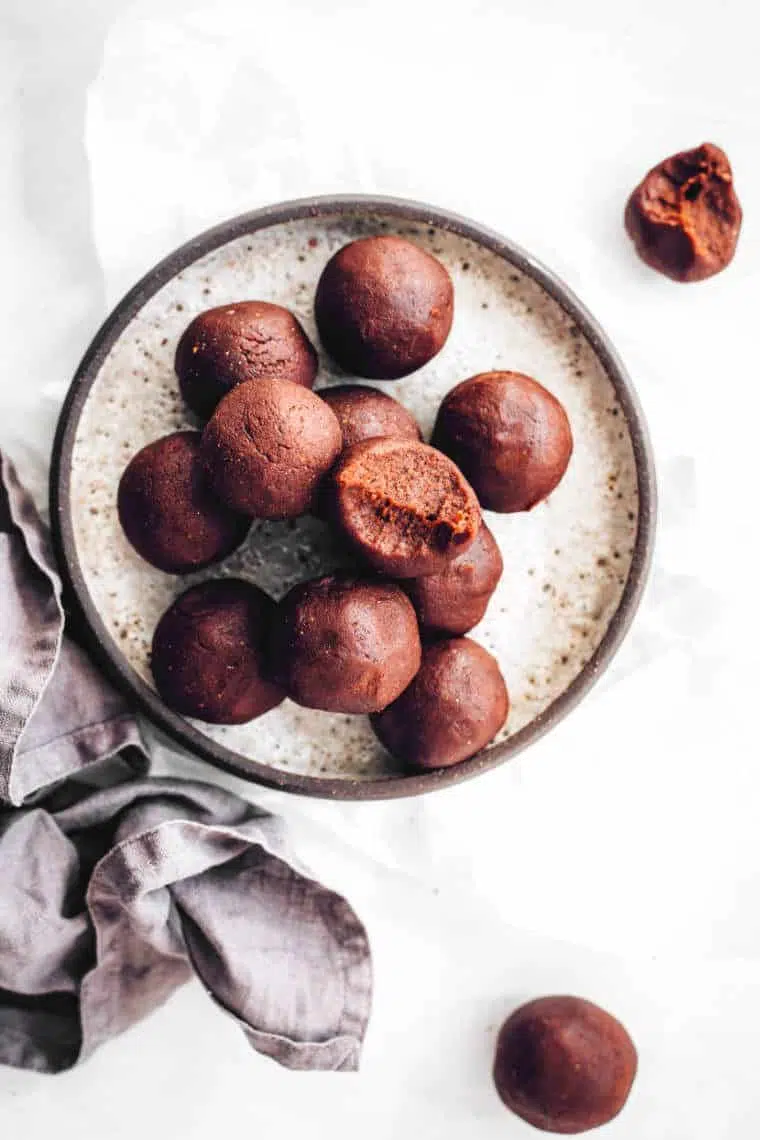
What are bliss balls?
Bliss balls, sometimes also called energy balls or protein balls, are very versatile healthy treats usually made from plant-based ingredients.
They range from sticky to crumbly, nutty to sweet and often feature dried fruit, nuts, seeds, oats and a plethora of spices.
Bliss balls are perfectly portable, super nutritious, great for healthy snacking and created within a couple of minutes! Plus, they work very well for meal prep and are kid-friendly.
Vegan Meal Prep Recipes →Common types
The biggest difference in our books is between bliss balls made with dates and those made without dates (like these date-free protein chickpea balls).
Using these whole fruits for sweetening is healthier than just adding syrup to your mixture — plus, they help create a creamy texture.
We love using dates for our bliss ball recipes — these are the most common combinations!
Are bliss balls healthy?
Generally speaking, yes! Most recipes for bliss balls rely on whole plant-based foods like nuts, oats or dates which provide your body with a lot of essential nutrients and enzymes.
They are also usually free from additives and raw or no-bake, packing a lot of fiber, healthy fats and natural sugars.
However, bliss balls can sometimes be made with a lot of syrup or refined sugar, coconut oil, chocolate or similar ingredients. While this makes the balls especially delicious, in this case, you should enjoy them in moderation.
Benefits of energy bites
- Often nutrient-packed
- Super kid-friendly
- Customizable to your dietary preferences
- Hundreds of flavoring options
- Delicious portable snack
- High in fiber
- Allergy-friendly
- Easy to make — even with kids
- Taste like dessert
- No-bake summer treat
- Support healthy eating habits
- Great for meal prep
- Little equipment needed
This might sound too good to be true and not every single one of these benefits applies to each energy balls recipe — but many people around the world love these healthy little snacks for exactly these reasons.
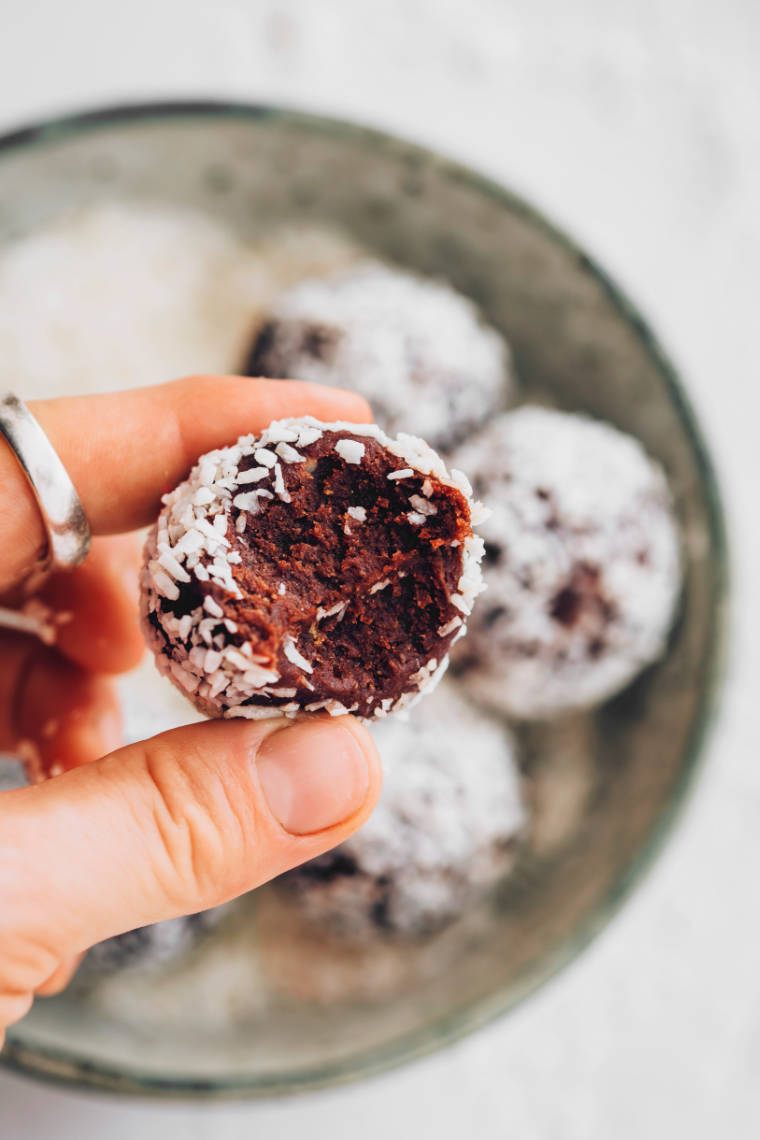
Typical ingredients for bliss balls
Recipes for bliss balls can vary widely (which makes them super fun and versatile!) but we have found that these components are often part of the mixture.
Nuts or nut butter
Healthy fats, fiber and some protein along with a wonderful texture! Ground nuts or almond meal make for crumblier dough while nut butter is a sticky component. Here are some examples:
- Peanut butter
- Cashew butter
- Almond butter
- Walnuts
- Cashews
- Almonds
Seeds or seed butter
Less often used in our everyday cooking and baking, seeds and seed butter are just as packed with vitamins and minerals, fats, protein and fiber! Here’s what you can add to your bliss balls:
- Chia seeds
- Flax seeds
- Sunflower seeds
- Pumpkin seeds
- Tahini (sesame seed butter)
- Sunflower butter

Sweeteners
Most bliss ball recipes are made either with syrup or dates as the sweet component. We like to go for whole food, natural sweeteners like dried fruit over refined sugars but you can choose from the following:
- Dates
- Raisins
- Goji berries
- Dried apricots
- Figs
- Agave syrup
- Maple syrup
- Rice syrup
- Stevia
- Sugar-free syrup
Starches
We love adding some complex carbs to our bliss balls! While most of the following ingredients are less commonly used, we highly recommend you play around with them.
- Rolled oats
- Instant oats
- White beans
- Black beans
- Chickpeas
- Pumpkin puree
- Sweet potato puree
- Mashed carrots
Spices & flavors
Anything goes here, from sweet to spicy and savory or even a combination! Try the following ideas for your bliss balls.
- Vanilla extract
- Cinnamon
- Cocoa powder
- Salt
- Nutmeg
- Lemon zest
- Orange zest
- Ground ginger
- Pumpkin pie spice
- Cayenne pepper
- Black pepper
- Cardamom
- Turmeric
- Almond extract
- Rum extract

Fun mix-ins
From sugary sprinkles to superfoods like chlorella, the sky’s the limit here! This is definitely the fun part and where you can add the most variety.
- Dark chocolate chips
- Sprinkles
- Cocoa nibs
- Pretzels
- Puffed quinoa
- Vegan protein powder
- Barley grass powder
- Matcha powder
- Shredded coconut
- Spirulina or chlorella
- Espresso powder
- Freeze-dried fruit
How to make bliss balls at home
If this is your first time making your own bliss balls, we recommend you follow an exact recipe. While it’s hard to fail at making bliss balls if you know the basics, it’s best to get a feel for the texture and combinations first.
It’s easiest to make bliss balls with a food processor but if you don’t have one, you can find tips for making energy balls without a food processor below.
We also recommend using a scale to measure your ingredients for best results (this is true for any recipe, not just bliss balls!) because a cup of loosely packed nuts or dates results in a completely different texture compared to tightly packed.
If you use dates that aren’t super moist, soak them in a small bowl covered with hot water for around 10 minutes and drain them before starting with the recipe.
The great thing about energy balls is that you can almost always just add all of the ingredients to your food processor, blend for a few minutes, then create the balls.

It basically works like this:
- Dump
- Mix
- Adjust
- Roll
- Eat
Did you catch that “adjust”? This might be the trickiest part because you want to end up with a sticky but not too wet and neither too crumbly texture.
If after 2 minutes or so, your dough hasn’t achieved the desired texture, you need to either add more of the dry ingredients or a splash of water. This will do the trick!
Finally, be sure not to over-blend your energy ball mixture because ingredients like nuts or nut butters can start releasing their oils.
To roll or create your bliss balls, you can use a cookie scoop, spoon or your wetted hands to scoop out around 1-inch or 1 tbsp amounts at a time. Roll between your palms to create little balls — feel free to decide how small or large you want them to be.
You can now enjoy your homemade bliss balls or roll them in a coating of your choice (see the “fun mix-ins” list above!)

FAQs & Tips
How to make bliss balls stick together
You need liquid and sticky components like dates, nut butter or maple syrup to make your bliss balls stick together. The mixture should be processed for around 1-2 minutes without over-blending — if it’s still too crumbly at this point, simply add some water and blend again.
How to store bliss balls
Bliss balls are best stored in the fridge but most can also be left out on the counter at room temperature. This highly depends on the exact ingredients and ratios used in your recipe.
Be sure to check for any tips from the author to see how to best store them.
Do energy balls need to be refrigerated?
Most energy balls do better when they are refrigerated, yes. When left out on the counter, they can dry out — or they can become too sticky when you use lots of wet ingredients.
You can take your bliss balls out of the fridge 15 minutes before eating them if you don’t want them to be super cold, though. A couple of hours at room temperature isn’t a problem either, so take them with you for a quick and easy snack!
Can you freeze bliss balls?
Yes. Once rolled, put them in a freezer-safe bag or sealed container and plate them in the freezer for up to 3 months.
When you’re ready to eat them, take your bliss balls out of the freezer and let them thaw in the fridge for a few hours.

How to pit dates
It’s important to remove the pit from your dates before putting them in your food processor! You can do this by using a knife to carefully slice each date lengthwise without cutting all the way through them.
Pry the sides open with your thumbs, push the back of the date with your index fingers to expose the pit. Pull it out and put it aside to compost later.
How to make protein balls
Using white or black beans alongside some dates and nuts is our favorite way of making protein-packed balls! However, you can also carefully choose higher-protein nuts and seeds such as peanuts and hemp seeds to bump up this macronutrient.
We like using this homemade vegan protein blend for a whole food version but store-bought (vegan) protein powders can also be added!
Finally, choose soy milk as a liquid add-in to help your mixture stick together.

How long do protein balls last?
Most energy balls will last for at least 1 week in the fridge and can also be stored in the freezer for a couple of months.
If you add beans or protein powder to your protein balls, you should definitely store them in the fridge as they will go bad quicker compared to nut or oat-based energy balls.
How do I create low-fat & high-fat versions?
Making your own bliss balls gives you the freedom to stick to your dietary preferences! Create low-fat balls by omitting any nuts and seeds and choosing ingredients such as oats, beans, dates or other dried fruit and spices.
If you want to create high-fat and low-sugar energy balls, go for lots of nuts and seeds, shredded coconut, dark chocolate and just a spritz of syrup or any sugar-free sweetener of your choice.
Can you eat raw oats in energy balls?
Instant oats or rolled oats aren’t actually raw, they have been separated and heated before packaging. While the final products are cold or “uncooked” when they are in your kitchen, they are technically not raw anymore.
Therefore, it’s absolutely no problem to use them in energy balls without first heating them!

How to make bliss balls without a food processor
When using mostly liquid and chopped ingredients, you don’t have to use a food processor to make bliss balls! Some recipes can be created in a high-speed blender instead.
And if you don’t want to use either of these tools, you can just mix bliss balls with certain ingredients in a bowl!
This works especially well for foods that don’t need to be broken down first. Good examples are nut butter, shredded coconut, liquid sweeteners like syrup, protein powder, instant oats and chocolate chips.
Coconut Bounty Balls →How many calories are in bliss balls?
Most bliss balls don’t just pack a good amount of nutrients, they are also decently high in calories! Since they mostly come from healthy whole foods, it’s usually not a big problem.
However, some people may underestimate how many calories a single bliss ball can contain (which varies hugely between recipes but can be around 100 calories easily) and might overdo it a bit. No judging, bliss balls are just so delicious!
How many energy bites should I eat?
It’s best to look for the nutritional information to determine how many energy bites are right for you. Are you someone who exercises a lot, only has a tiny appetite or needs to gain some weight?
Eat as many as you want without feeling sick or pushing other important foods off your plate!
If you are looking to lose weight or have a hard time moderating your intake, stick to 1-2 balls at a time.

When should you eat energy balls?
From first thing in the morning to late-night snacking, energy balls can be enjoyed at any time of the day!
They are great as a pre-workout snack since they provide quick and steady energy without filling your stomach up very much. You can also eat energy balls right after exercising to replenish glycogen levels.
You can find some information about how to make protein-rich balls above.
More vegan articles
If you liked our guide to creating easy and healthy bliss balls, why not read more about plant-based nutrition and how to implement all of this in your everyday life?
Now that you know how to make bliss balls, we’re curious to read about your experiences! Share them in the comments below and Pin our guide here for future reference.

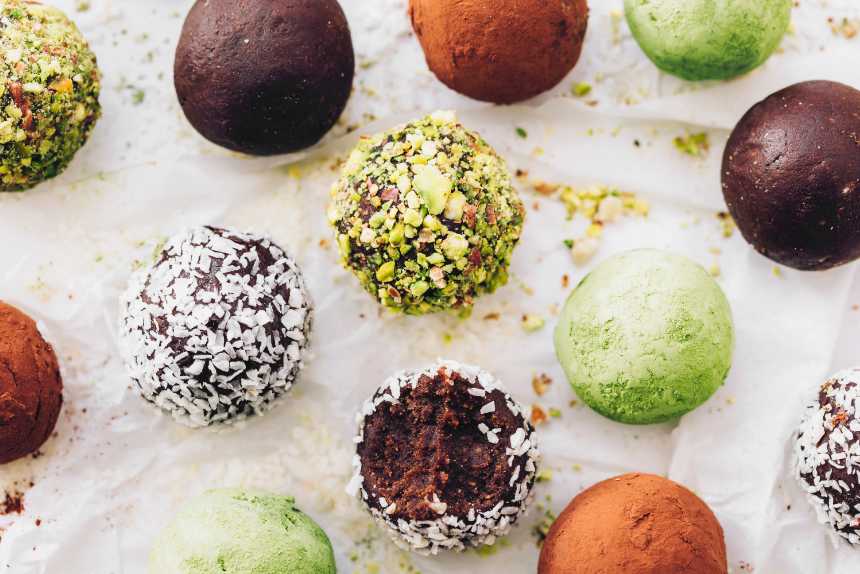

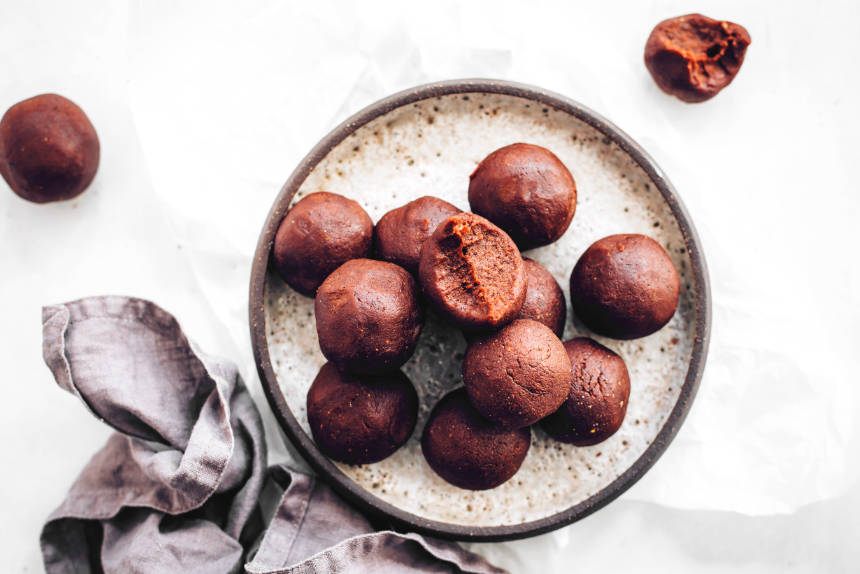




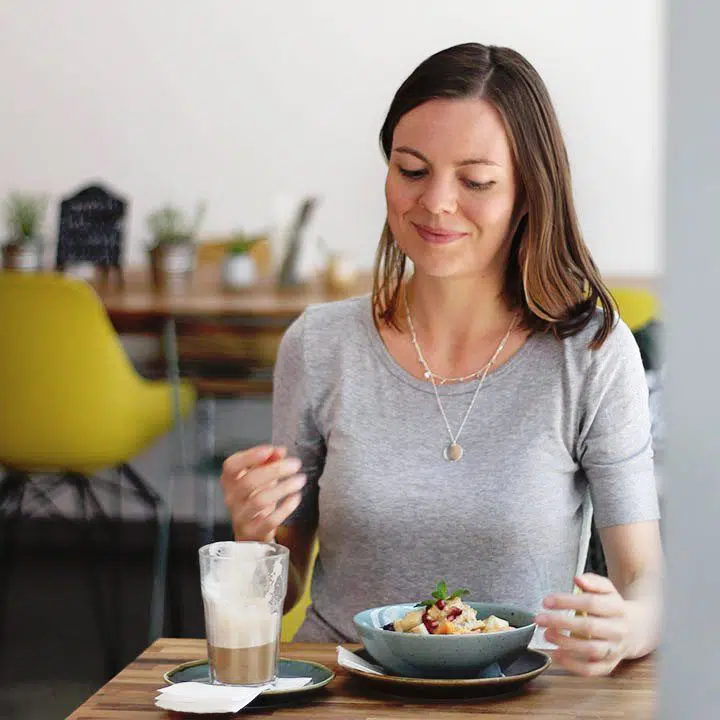
 Alena Schowalter is a Certified Vegan Nutritionist who has been a vegetarian since childhood and vegan since 2012. Together with her husband, she founded nutriciously in 2015 and has been guiding thousands of people through different transition stages towards a healthy plant-based diet. She’s received training in the fields of nutrition, music therapy and social work. Alena enjoys discussions around vegan ethics, walks through nature and creating new recipes.
Alena Schowalter is a Certified Vegan Nutritionist who has been a vegetarian since childhood and vegan since 2012. Together with her husband, she founded nutriciously in 2015 and has been guiding thousands of people through different transition stages towards a healthy plant-based diet. She’s received training in the fields of nutrition, music therapy and social work. Alena enjoys discussions around vegan ethics, walks through nature and creating new recipes.
Yes please…
This would be a most wonderful addition to my family snack addiction. :)
just sent you the free guide :)
I made them today with half a cup of tahini (as it’s more liquid than nut butter) and a quarter cup of cacao and a pinch of salt. We’re having trouble not demolishing the lot! Thanks – a blueprint was exactly what I was looking for!
thank you so much for the stellar feedback, Sarah! Tahini is really delicious, I can only image how wonderful your bliss balls must have tasted :)